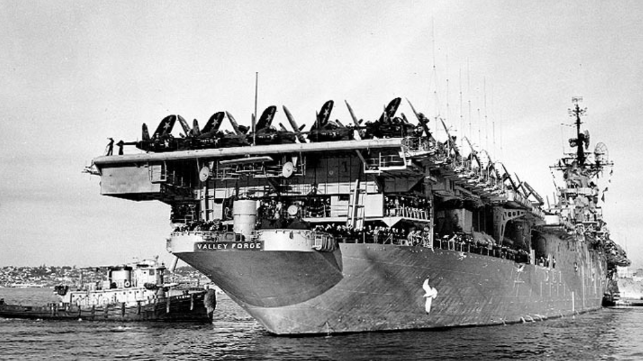70 Years Ago: The "Forgotten War" and the Fight to Hold Pusan

Before dawn on the morning of June 25, 1950, Communist North Korea launched a massive surprise attack across the border into South Korea, smashing through the inadequate South Korean defenses. Within three days, the North Korean People’s Army (NKPA) had captured the South Korean capital of Seoul and kept on going south, with little to stop them. The attack not only took the South Koreans by surprise, it caught the United States unprepared for war.
To the extent that the U.S. was planning for war in 1950, it was almost exclusively focused on a potential Soviet invasion of Europe, which would be deterred or won by U.S. Air Force intercontinental bombers armed with atomic bombs. The U.S. Navy had repeatedly lost the budget battles, service roles and missions battles of the late 1940s, and the size, capability and readiness of the Navy was a pale shadow of what it had been at the Japanese surrender only five years before.
As it turned out, the U.S. Army was in even worse shape than the Navy, and the first combat actions between the Army and the NKPA were humiliating defeats for the U.S., with several thousand American soldiers killed and captured. It was also apparent that the massive U.S. Air Force investment in long-range nuclear bombers was useless in a war in which the object was to stop North Korean aggression, without also starting a full-scale war with the Soviet Union. And without airfields in Korea, the USAF’s tactical aircraft ability to affect the battle from bases in Japan was severely constrained.
The U.S. Navy presence in the Western Pacific in 1950 had been reduced to one aircraft carrier (USS Valley Forge), two cruisers and a handful of destroyers, which were severely short of ammunition and underway logistics support. Nevertheless, it was this naval force - augmented by a smaller British carrier (HMS Triumph) and other allied ships under a (U.S.-led) United Nations command structure - that played a key role in establishing command of the air and of the sea. Without control of the vital sea-lanes, there is little doubt that by August 1950, the North Koreans would have been in possession of the entire Korean Peninsula. It was U.S. Navy amphibious capability, as enfeebled as it was by budget cuts, that put a well-trained U.S. Marine Brigade into Korea, just in time to stiffen the defense of the Pusan Perimeter and prevent the last UN toehold in South Korea from being overrun.
The miniscule Republic of Korea Navy (ROKN) acquitted itself well, particularly in a small battle with major strategic consequences. On June 26, 1950, the largest warship in the ROKN (a submarine chaser) sank a North Korean transport with 600 troops embarked, which was attempting a surprise seizure of the port of Pusan.
The U.S. and allied navies were in the action almost immediately, with two U.S. destroyers covering the evacuation of U.S. and friendly foreign nationals from Seoul on the second day of the war. On July 2, 1950, light cruiser USS Juneau and two Allied ships sank three of four North Korean PT-boats and two of two motor gunboats in the Battle of Chumonchin Chan, the first and last surface engagement between the U.S. and North Korean Navies during the war.
On July 3, the carriers USS Valley Forge and HMS Triumph caught the North Koreans by surprise with a strike from the Yellow Sea into the capital Pyongyang. Although hampered by lack of underway ammunition resupply and refueling, the two carriers bounced back and forth between the Yellow Sea and the Sea of Japan, so the North Koreans could never be sure from which direction they would be hit.
Bombardment by Allied ships on the peninsula's west coast (especially challenging given extreme tidal conditions) and by U.S. ships on the east coast made the North Koreans pay a heavy price for their advance. Naval gunfire on the east coast became even more effective when the heavy cruisers Helena and Toledo with 8-inch guns arrived within a month to augment USS Rochester. U.S. surface ships ranged far to the north along the Korean coast, shelling key North Korean ports.
The arrival of a second U.S. carrier (USS Philippine Sea) enabled near continuous carrier strikes on North Korean targets. The arrival of two escort carriers, Badoeng Strait and Sicily, each with a Marine Corsair squadron embarked, provided air support that enabled the 1st Provisional Marine Brigade to repel North Korean breakthroughs on the hard-pressed Pusan perimeter.
Compared to the massive casualties suffered by the U.S. and ROK Armies, the cost to the U.S. Navy in the first months of the war was relatively light, with only a handful of aircraft shot down (and even more lost to operational causes than the enemy.)
That the U.S. Navy accomplished anything at all was a testament to the leaders and sailors who hadn’t forgotten how to win, despite shortfalls in just about everything. In 1949, the general consensus in the new unified Department of Defense was that the Navy was obsolete, and the Secretary of Defense cancelled the next generation aircraft carrier (USS United States) and gave orders to reduce the number of operational fleet carriers from eight to four. An additional draconian budget cut in mid-1949, if implemented, would have meant putting every aircraft carrier into mothballs, along with the last battleship that wasn’t already in reserve. Upon the outbreak of the Korean War, the Truman administration suddenly discovered that a Navy really can come in handy, and can do things that strategic bombers and atomic weapons cannot.
Rear Adm. Samuel Cox is the director of the Naval History and Heritage Command.
The opinions expressed herein are the author's and not necessarily those of The Maritime Executive.

